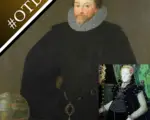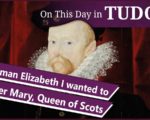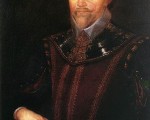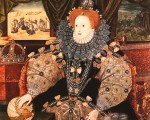
On this day in Tudor history, 4th April, writer William Strachey, whose account of a shipwreck inspired Shakespeare, was born; Francis Drakes was knighted by Elizabeth I; and noblewoman and scholar Mildred Cecil, Lady Burghley, died…
[Read More...]
On this day in Tudor history, 4th April, writer William Strachey, whose account of a shipwreck inspired Shakespeare, was born; Francis Drakes was knighted by Elizabeth I; and noblewoman and scholar Mildred Cecil, Lady Burghley, died…
[Read More...]
On this day in Tudor history, 23rd September 1568, in the reign of Queen Elizabeth I, the Battle of San Juan de Ulúa took place near present day Veracruz in Mexico.
The battle was fought between Spanish forces and English privateers led by John Hawkins. The Spanish forces were victorious.
[Read More...]
On this day in Tudor history, 4th April 1581, Francis Drake, the famous Elizabethan explorer, sea captain and pirate, was awarded a knighthood by Elizabeth I. He was dubbed by Monsieur de Marchaumont on board the Golden Hind at Deptford.
The knighthood was a reward for Drake’s 1577-80 expedition, which saw him plundering Spanish ports, capturing Spanish ships, claiming Point Loma for England as Nova Albion, circumnavigating the globe, and more importantly, bringing back a rich cargo of treasure and spices for his queen.
[Read More...]
On this day in Tudor history, 13th December 1577, in the reign of Queen Elizabeth I, Sir Francis Drake set off from Plymouth on his circumnavigation of the Globe.
Today, I share a letter written by the pirate, sea captain, and explorer to Sir Francis Walsingham. You can find out more about his voyages, and his life and career, at the links below.
[Read More...]
On this day in Tudor history, 26th September 1580, in the reign of Queen Elizabeth I, explorer Sir Francis Drake landed at the port of Plymouth.
He was returning from his 3-year circumnavigation of the Globe and his ship, The Golden Hind, was laden with treasure and spices.
Let me tell you about his circumnavigation of the Globe, what he brought back, and how the queen rewarded him for his efforts…
[Read More...]
On this day in Tudor history, 19th April 1601, in Elizabeth I’s reign, bookseller James Duckett was hanged at Tyburn. Being a bookseller in Tudor times could be a risky business, particularly if you had the wrong kind of books on your premises!
[Read More...]
On this day in Tudor history, 26th September 1588, Sir Amias (Amyas) Paulet, administrator, diplomat, Governor of Jersey and gaoler of Mary, Queen of Scots died. He was buried in St Martin-in-the-Fields, Westminster.
Sir Amias Paulet acted as gaoler to Mary, Queen of Scots, and it was while he was doing this that Elizabeth wanted him to abide by the Bond of Association and assassinate Mary, Queen of Scots, so that she didn’t have to sign her death warrant.
What was the Bond of Association and what did Paulet do?
Find out…
[Read More...]
In this second part of This Week in Tudor history, which covers 1st to 4th April, historian and author Claire Ridgway talks about Thomas Churchyard, a poet and soldier who kept being imprisoned; Sir Ambrose Cave, a man who joined the Order of St John as early as he possibly could, but survived its dissolution and ended his days serving Elizabeth I; before moving on to the death of Elizabeth Boleyn, Countess of Wiltshire, mother of Queen Anne Boleyn and grandmother of Queen Elizabeth I, and finishing with the knighting of explorer Francis Drake.
[Read More...]
On this day in Tudor history, 26th September 1580, in the reign of Queen Elizabeth I, Sir Francis Drake returned from his 3-year circumnavigation of the Globe. Drake landed at the port of Plymouth, in his ship, The Golden Hind, which was laden with treasure and spices.
In today’s talk, I give details about his circumnavigation of the Globe, what he brought back, and how Queen Elizabeth I rewarded him for his efforts.
[Read More...]
On this day in Tudor history, 19th April 1587, Sir Francis Drake “singed the King of Spain’s beard”, as he called it, by attacking the Spanish fleet in the harbour of Cadiz.
Drake’s actions on that day and the following few days meant that King Philip had to postpone his plans for the Spanish Armada to attack England – phew!
[Read More...]
Sir Francis Drake died on this day in Tudor history in 1596, but who was he? I share some Francis Drake facts and two legends that surround this colourful man.
[Read More...]
On this day in history, 26th September 1580, Sir Francis Drake returned to England from his 3-year circumnavigation of the Globe, arriving at the port of Plymouth in The Golden Hind, which was laden with treasure and spices.
Drake had left Plymouth on his travels on 13th December 1577 with his fleet of five ships. Storm damage to two of his ships had delayed his departure. The purpose of this journey had been to sail into the Pacific and raid the Spanish colonies there. It was a secret mission authorised by Queen Elizabeth I, and investors of Drake’s mission included the Queen, Sir Francis Walsingham, William and George Wynter, Christopher Hatton and John Hawkins. Only one ship, The Pelican”, made it safely to the Pacific, arriving there in October 1578. As a tribute to its success, it was renamed The Golden Hind, after Sir Christopher Hatton’s coat of arms. Drake then sailed along South America’s Pacific coast, plundering towns and Spanish ports, and capturing Spanish ships laden with gold, silver and jewels.
[Read More...]
On 30th July 1588, the day after the Battle of Gravelines and the defeat of the Spanish Armada, the wind changed and the remaining ships of the Spanish Armada were forced northwards and scattered. It really did seem that the elements, particularly the wind, were on England’s side. Sir Francis Drake wrote to Sir Francis Walsingham on 30th July 1588, saying “There was never anything pleased me better than seeing the enemy flying with a southerly wind northward. We have the Spaniards before us, and the mind, with the grace of God, to wrestle a pull with them.”
[Read More...]
On the 27th January 1596, Sir Francis Drake, explorer, sea captain and pirate, died of dysentery in Portobelo harbour, Panama. When he realised that death was near, he asked to be dressed in his armour. Although he requested burial on land, Drake was buried at sea in a lead coffin, along with his second cousin, Admiral Sir John Hawkins.
Drake made his first voyage to the New World at the age of around twenty-three, with Hawkins, whose family owned a fleet of ships based in Plymouth. Another voyage saw the fleet trapped by Spaniards in the Mexican port of San Juan de Ulua in 1568. Fortunately, the two men managed to escape, but they lost all but two of their fleet. In 1570 and 1571, Drake undertook two trading voyages to the West Indies, and in 1572 took two ships on a marauding campaign against the Caribbean’s Spanish ports. Drake was able to capture the port of Nombre de Dios and return to England, his ships laden with Spanish booty. In 1573 Drake attacked a mule train with the help of Guillaume Le Testu, the French buccaneer, capturing around 20 tons of gold and silver.
[Read More...]
On 13th December 1577, Sir Francis Drake finally left Plymouth with his fleet of five ships on a journey which would see him circumnavigating the Globe. Storm damage to two of his ships had scuppered earlier plans.
The purpose of this journey was to sail into the Pacific and raid the Spanish colonies there. It was a secret mission authorised by Queen Elizabeth I and investors of Drake’s mission included the Queen, Sir Francis Walsingham, William and George Wynter, Christopher Hatton and John Hawkins.
[Read More...]
]On the 27th January 1596, Sir Francis Drake, explorer, sea captain and pirate, died of dysentery in Portobelo harbour, Panama. When he realised that death was near, he asked to be dressed in his armour. Although he requested burial on land, Drake was buried at sea in a lead coffin, along with his second cousin, Admiral Sir John Hawkins.
Here are some facts about Sir Francis Drake, the famous Elizabethan sailor and navigator…
[Read More...]